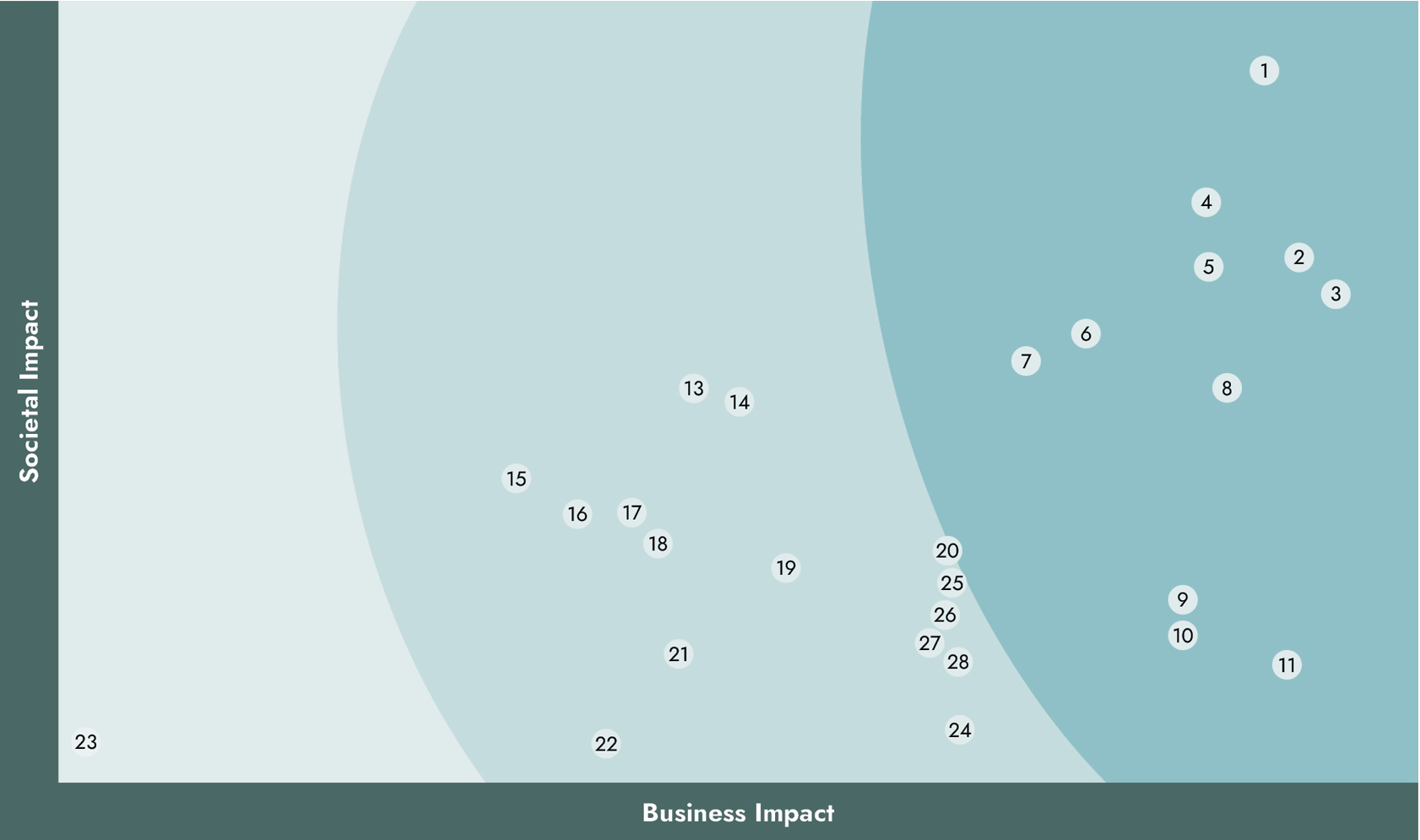Materiality Assessment
Conducting a materiality assessment is pivotal for our Company as it allows us to prioritise the factors that significantly influence our value creation process. Guided by our dedication to upholding ESG principles, we have undertaken a thorough materiality evaluation, enabling us to identify and prioritise critical areas across all facets of our business operations.
Process of Determination of Material Topics
Our latest Materiality Assessment for FY 2023-24 involved a comprehensive four-step methodology.
Research on Relevant Material Topics: We conducted a desktop assessment on pertinent material topics, leveraging insights from industry trends, peer benchmarking, and adherence to industry-specific standards across our verticals. Following internal assessments and discussions with senior management, we identified 28 material topics for evaluation.
The industry-specific standards considered for material topic selection are:
Real Estate
Morgan Stanley Capital International (MSCI)
Sustainability Accounting Standards Board (SASB)
Global Real Estate Sustainability Benchmark (GRESB)
International Sustainability Standards Board (ISSB)
Pulp and Paper
Morgan Stanley Capital International (MSCI)
Sustainability Accounting Standards Board (SASB)
Forest Stewardship Council (FSC)
International Finance Corporation (IFC)
World Bank
Stakeholder Identification and Prioritisation
Subsequently, we engaged in stakeholder identification to discern those who could offer valuable insights into pertinent issues. Stakeholders encompassed senior management (BoDs, KMPs, CEO, HoDs), customers, employees, supply chain partners, local communities, and investors. Through surveys and discussions, stakeholders were prioritised based on their influence and dependency on our business.
Stakeholder Engagement for Topic Prioritisation
We circulated detailed survey forms tailored to different stakeholder groups to elicit their perspectives on key issues, risks, and opportunities associated with each material topic. Separate survey forms were circulated separately to the different stakeholder groups. A business impact assessment form was circulated among the leadership and employees of our Company and the Societal Impact assessment form was filled out by the workers and other external stakeholders.
Identification of High Priority Material Topics
Following the collation of stakeholder responses, topics were assessed, prioritised, and discussed with senior management to finalise the relevant material topics. This process resulted in the ranking of 11 high-priority material topics and the formulation of the Materiality Matrix. Regulatory standards' requirements were also factored into the prioritisation process.
Process of material topics identification
Identifying relevant material topics.
Assess and discuss the topics.
Stakeholder prioritisation
Preparation of survey forms
Circulate the survey forms
Collect the results and discuss.
Major material topic selection
The approach involved a meticulous assessment of material topics across business segments, prioritising them based on their impact on both business and society. By analysing ratings separately from both the business segments and the HO team, commonalities were identified, highlighting key priorities for us. Topics that consistently rated highly across segments and deemed crucial to both business and society were designated as key material topics. Additionally, insights from senior management led to the inclusion of certain topics, such as waste management, despite not initially ranking as a top material topic.
The outcomes of our materiality exercise have played a pivotal role in shaping our ESG approach. They have equipped us with a profound understanding of areas where our impact can be most significant, facilitating positive change. Our continuous endeavours are closely aligned with these priorities, focussing on risk mitigation, seizing opportunities, and nurturing sustainable value for all stakeholders.
Materiality Matrix
We have strategically mapped out key sustainability topics across the ESG domains of Environment (E), Social (S), and Governance (G), integrating connections to relevant SDGs and initiatives. Through this process, we have categorised insights into high, medium, and low priorities, guiding focussed action and resource allocation in line with our sustainability goals.
-
1
Business Ethics
-
2
ESG Incident and Risk Management
-
3
Occupational Health and
-
4
Data Privacy and Cybersecurity
-
5
Compliance
-
6
Customer Experience and Satisfaction
-
7
Brand Management
-
8
Corporate Governance
-
9
Waste Management
-
10
Energy and Emissions Management
-
11
Water and Wastewater Management
-
12
Technology Upgradation & Information Communication Technology (ICT)
-
13
Human Rights
-
14
Grievance Redressal
-
15
Research and development
-
16
Climate Change Adaptation and Mitigation
-
17
Training & Capacity Building
-
18
Chemical Safety
-
19
Diversity and Inclusion
-
20
Talent Management
-
21
Corporate Social Responsibility
-
22
Biodiversity Management
-
23
Sustainable Packaging
-
24
On-Site Air Emissions
-
25
Sustainable Products and Brands
-
26
Employee Retention
-
27
Responsible Sourcing Practices
-
28
Product Carbon Footprint
Identified Key Material Topics:
Business Ethics
Data Privacy and Cybersecurity
Occupational Health and Safety
Compliance
Corporate Governance
ESG Incident and Risk Management
Customer Experience and Satisfaction
Brand Management
Energy and Emissions Management
Water and Wastewater Management
Waste Management
-
Environmental Material Topics
Energy and Emissions Management
Water and Wastewater Management
Waste Management
-
NGRBC Principle
Principe 6
Principe 6
Principe 6
-
SDG Alignment











-
IR Capital Alignment
Natural Capital
Natural Capital
Natural Capital
-
Social Material Topics
Occupational Health and Safety
Customer Experience and Satisfaction
-
NGRBC Principle
Principle 3
Principle 9
-
SDG Alignment











-
IR Capital Alignment
Human Capital
Social and Relationship Capital
-
Governance Material Topics
Business Ethics
Data Privacy and Cybersecurity
Compliance
Corporate Governance
ESG Incident and Risk Management
Brand Management
-
NGRBC Principle
Principle 1, Principle 7
Principle 9
Section A and Principle 6
Section A
Section A, Principle 2, Principle 3
Principle 2, Principle 9
-
SDG Alignment















-
IR Report Alignment
Corporate Governance Report
Social and Relationship Capital
Governance and Corporate Governance Report
Corporate Governance Report
Value Creation Manufacturing Capital, Social and Relationship Capital

